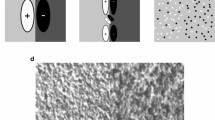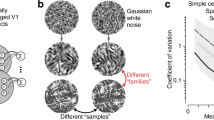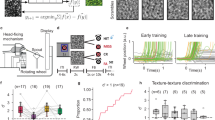Abstract
Cuing covert spatial attention can increase spatial resolution. Here we pinpointed the specific locus of this effect using texture segmentation. At the level of visual cortex, texture segmentation theoretically involves passage of visual input through two layers of spatial linear filters separated by a pointwise nonlinearity. By manipulating the textures to differentially stimulate first- or second-order filters of various scales, we showed that the attentional effect consistently varied with the latter. These psychophysical results further support the hypothesis that attention increases resolution at the attended location and are consistent with an effect of attention at stages as early as the primary visual cortex.
This is a preview of subscription content, access via your institution
Access options
Subscribe to this journal
Receive 12 print issues and online access
$209.00 per year
only $17.42 per issue
Buy this article
- Purchase on Springer Link
- Instant access to full article PDF
Prices may be subject to local taxes which are calculated during checkout




Similar content being viewed by others
References
Yeshurun, Y. & Carrasco, M. Attention improves or impairs visual performance by enhancing spatial resolution. Nature 396, 72–75 (1998).
Yeshurun, Y. & Carrasco, M. Spatial attention improves performance in spatial resolution tasks. Vision Res. 39, 293–305 (1999).
Carrasco, M. & Yeshurun, Y. The contribution of covert attention to the set-size and eccentricity effects in visual search. J. Exp. Psychol. Hum. Percept. Perform. 24, 673–692 (1998).
Carrasco, M., Penpeci-Talgar, C. & Eckstein, M. Spatial covert attention increases contrast sensitivity along the CSF: Support for signal enhancement. Vision Res. 40, 1203–1215 (2000).
Posner, M. I. Orienting of attention. Q. J. Exp. Psychol. 32, 3–25 (1980).
Kinchla, R. A. Attention. Annu. Rev. Psychol. 43, 711–742 (1992).
Prinzmetal, W., Amiri, H., Allen, K. & Edwards T. Phenomenology of attention: 1. color, location, orientation, and spatial frequency. J. Exp. Psychol. Hum. Percept. Perform. 24, 1–22 (1998).
Sperling G. & Dosher B. A. in Handbook of Perception and Human Performance Vol. 1 (eds. Boff, K. R., Kaufman, L. & Thomas, J. P.) 1–65 (Wiley, New York, 1986).
Shiu L. & Pashler, H. Spatial attention and vernier acuity. Vision Res. 35, 337–343 (1995).
Balz, G. W. & Hock, H. S. The effect of attentional spread on spatial resolution. Vision Res. 37, 1499–1510 (1997).
Morgan, M. J., Ward, R. M. & Castet, E. Visual search for a tilted target: Tests of spatial uncertainty models. Q. J. Exp. Psychol. A 51, 343–370 (1998).
Tsal, Y. & Shalev, L. Inattention magnifies perceived length: The attentional receptive field hypothesis. J. Exp. Psychol. Hum. Percept. Perform. 22, 233–243 (1996).
Lee, D. K., Itti, L., Koch, C. & Braun, J. Attention activates winner-take-all competition among visual filters. Nat. Neurosci. 2, 375–381 (1999).
Lu, Z. L. & Dosher, B. A. External noise distinguishes attention mechanisms. Vision Res. 38, 1183–1198 (1998).
Desimone R. & Duncan J. Neural mechanisms of selective visual attention. Annu. Rev. Neurosci. 18, 193–222 (1995).
Purpura, K. P., Victor, J. D. & Katz, E. Striate cortex extracts higher-order spatial correlations from visual textures. Proc. Natl. Acad. Sci. USA 91, 8482–8486 (1994).
Lamme, V. A. F. The neurophysiology of figure-ground segregation in primary visual cortex. J. Neurosci. 15, 1605–1615 (1995).
Lamme, V. A. F., Van Dijk, B. W. & Spekreijse, H. Organization of texture segregation processing in primate visual cortex. Vis. Neurosci. 10, 781–790 (1993).
DeValois, R. L. & DeValois, K. K. Spatial Vision (Oxford Univ. Press, New York, 1988).
Graham, N. Visual Pattern Analyzers (Oxford Univ. Press, New York, 1989).
Gurnsey, R., Pearson, P. & Day, D. Texture segmentation along the horizontal meridian: nonmonotonic changes in performance with eccentricity. J. Exp. Psychol. Hum. Percept. Perform. 22, 738–757 (1996).
Kehrer, L. Central performance drop on perceptual segregation tasks. Spat. Vis. 4, 45–62 (1989).
Kehrer, L. The central performance drop in texture segmentation: a simulation based on a spatial filter model. Biol. Cybern. 77, 297–305 (1997).
Bergen, J. R. & Landy, M. S. in Computational Models of Visual Processing (eds. Landy, M. S. & Movshon, J. A.) 253–271 (MIT Press, Cambridge, Massachusetts, 1991).
Sutter, A., Beck, J. & Graham, N. Contrast and spatial variables in texture segregation: testing a simple spatial-frequency channels model. Percept. Psychophys. 46, 312–332 (1989).
Graham, N., Beck, J. & Sutter, A. Nonlinear processes in spatial-frequency channel models of perceived texture segregation: Effects of sign and amount of contrast. Vision Res. 32, 719–743 (1992).
Graham, N., Sutter, A. & Venkatesan, C. Spatial-frequency and orientation-selectivity of simple and complex channels in region segregation. Vision Res. 33, 1893–1911 (1993).
Malik, J. & Perona, P. Preattentive texture discrimination with early vision mechanisms J. Opt. Soc. Am. A 7, 923–932 (1990).
Kingdom, F. A. A. & Keeble, D. R. T. A linear systems approach to the detection of both abrupt and smooth spatial variations in orientation-defined textures. Vision Res. 36, 409–420 (1996).
Rubenstein, B. S. & Sagi, D. Spatial variability as a limiting factor in texture discrimination tasks: implications for performance asymmetries. J. Opt. Soc. Am. A, 7, 1632–1643 (1990).
DeValois, R. L., Albrecht, D. G. & Thorell, L. G. Spatial frequency selectivity of cells in macaque visual cortex. Vision Res. 22, 545–559 (1982).
Solomon, J. A. & Pelli, D. G. The visual filter mediating letter identification. Nature 369, 395–397 (1994).
Stromeyer, C. F., Klein, S. & Sternheim, C. E. Is spatial adaptation caused by prolonged inhibition? Vision Res. 17, 603–606 (1977).
Jonides, J. in Attention and Performance Vol. IX (eds. Long, J. B. & Baddeley, A. D.) 187–204 (Erlbaum, Hillsdale, New Jersey, 1981).
Robson, J. G. & Graham, N. Probability summation and regional variations in contrast sensitivity curves across the visual field. Vision Res. 21, 408–418 (1981).
Sutter, A., Sperling, G. & Chubb, C. Measuring the spatial frequency selectivity of second-order texture mechanisms. Vision Res. 35, 915–924 (1995).
Moran, J. & Desimone, R. Selective attention gates visual processing in the extrastriate cortex. Science 229, 782–784 (1985).
Luck, S. J., Chelazzi, L., Hillyard, S. A. & Desimone, R. Neural mechanisms of spatial selective attention in areas V1, V2, and V4 of macaque visual cortex. J. Neurophysiol. 77, 24–42 (1997).
Reynolds, J. H. & Desimone, R. The role of neural mechanisms of attention in solving the binding problem. Neuron 24, 19–29 (1999).
Graham, N. & Sutter, A. Spatial summation in simple (Fourier) and complex (Non-Fourier) texture channels. Vision Res. 38, 231–257 (1998).
Heeger, D. J. Model for the extraction of image flow. J. Opt. Soc. Am. A 4, 1455–1471 (1987).
Grossberg, S. & Mingolla, E. Neural dynamics of perceptual grouping: textures, boundaries, and emergent features. Percept. Psychophys. 38, 141–171 (1985).
Foley, J. M. Human luminance pattern-vision mechanisms: Masking experiments require a new model. J. Opt. Soc. Amer. A 11, 1710–1719 (1994).
Sagi, D. Detection of an orientation singularity in Gabor textures: effect of signal density and spatial-frequency. Vision Res. 30, 1377–1388 (1990).
Joseph, J. S., Chun, M. M. & Nakayama, K. Attentional requirements in a ‘preattentive’ feature search task. Nature 387, 805–807 (1997).
Motter, B. M. Focal attention produces spatially selective processing in visual cortical areas V1, V2, and V4 in the presence of competing stimuli. J. Neurophysiol. 70, 909–919 (1993).
Ito, M. & Gilbert, C. D. Attention modulates contextual influences in the primary visual cortex of alert monkeys. Neuron 22, 593–604 (1999).
Brefczynski, J. A. & DeYoe, E. A. A physiological correlate of the ‘spotlight’ of visual attention. Nat. Neurosci. 2, 370–374 (1999).
Gandhi, S. P., Heeger, D. J. & Boynton, G. M. Spatial attention affects brain activity in human primary visual cortex. Proc. Natl. Acad. Sci. USA 96, 3314–3319 (1999).
Martinez, A. et al. Involvement of striate and extrastriate visual cortical areas in spatial attention. Nat. Neurosci. 2, 364–369 (1999).
Acknowledgements
This study was supported by an NSF National Young Investigator Grant, a Cattell Sabbatical Fellowship and a Guggenheim Fellowship to M.C. We thank A.M. Vaduva for assistance in collecting data for experiment 2 and L. Cameron, E. Davis, J.D. Fernández, K. Frieder, M. Landy, L. Maloney, D. Pelli, C. Penpeci-Talgar, Y. Tsal and S. Wolfson for comments on a draft of this manuscript.
Author information
Authors and Affiliations
Corresponding author
Rights and permissions
About this article
Cite this article
Yeshurun, Y., Carrasco, M. The locus of attentional effects in texture segmentation. Nat Neurosci 3, 622–627 (2000). https://doi.org/10.1038/75804
Received:
Accepted:
Issue Date:
DOI: https://doi.org/10.1038/75804
This article is cited by
-
Attention amplifies neural representations of changes in sensory input at the expense of perceptual accuracy
Nature Communications (2020)
-
Peripheral visual localization is degraded by globally incongruent auditory-spatial attention cues
Experimental Brain Research (2019)
-
Visual learning with reduced adaptation is eccentricity-specific
Scientific Reports (2018)
-
How visual spatial attention alters perception
Cognitive Processing (2018)
-
Unraveling Causal Mechanisms of Top-Down and Bottom-Up Visuospatial Attention with Non-invasive Brain Stimulation
Journal of the Indian Institute of Science (2017)



